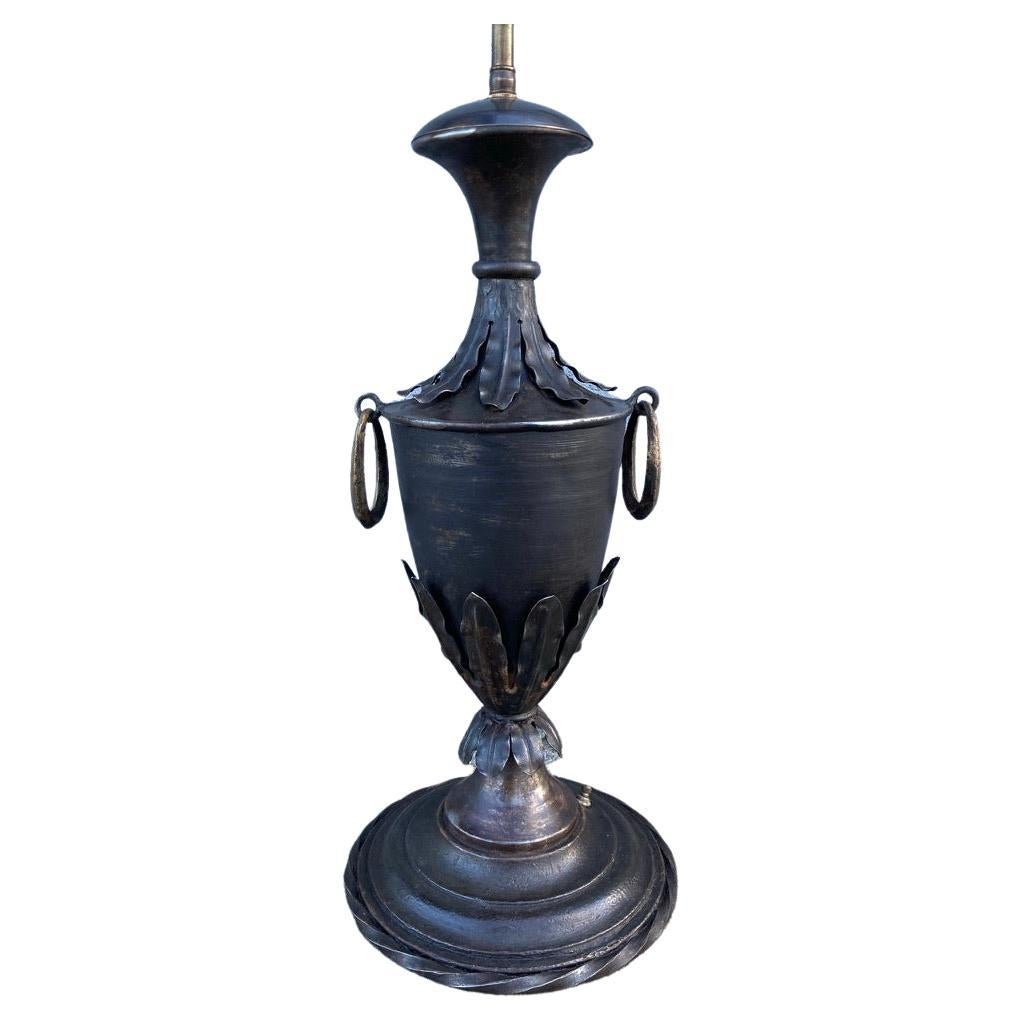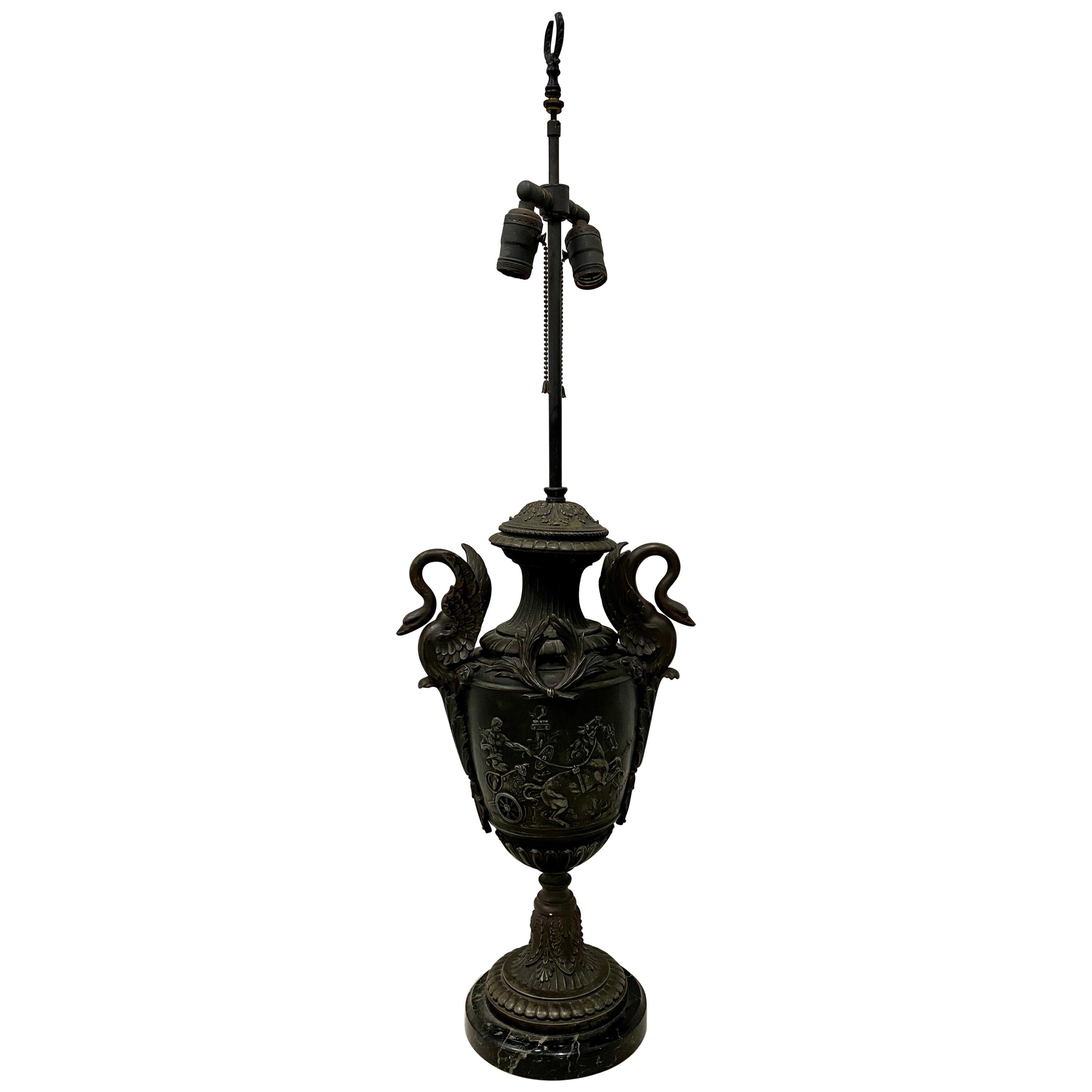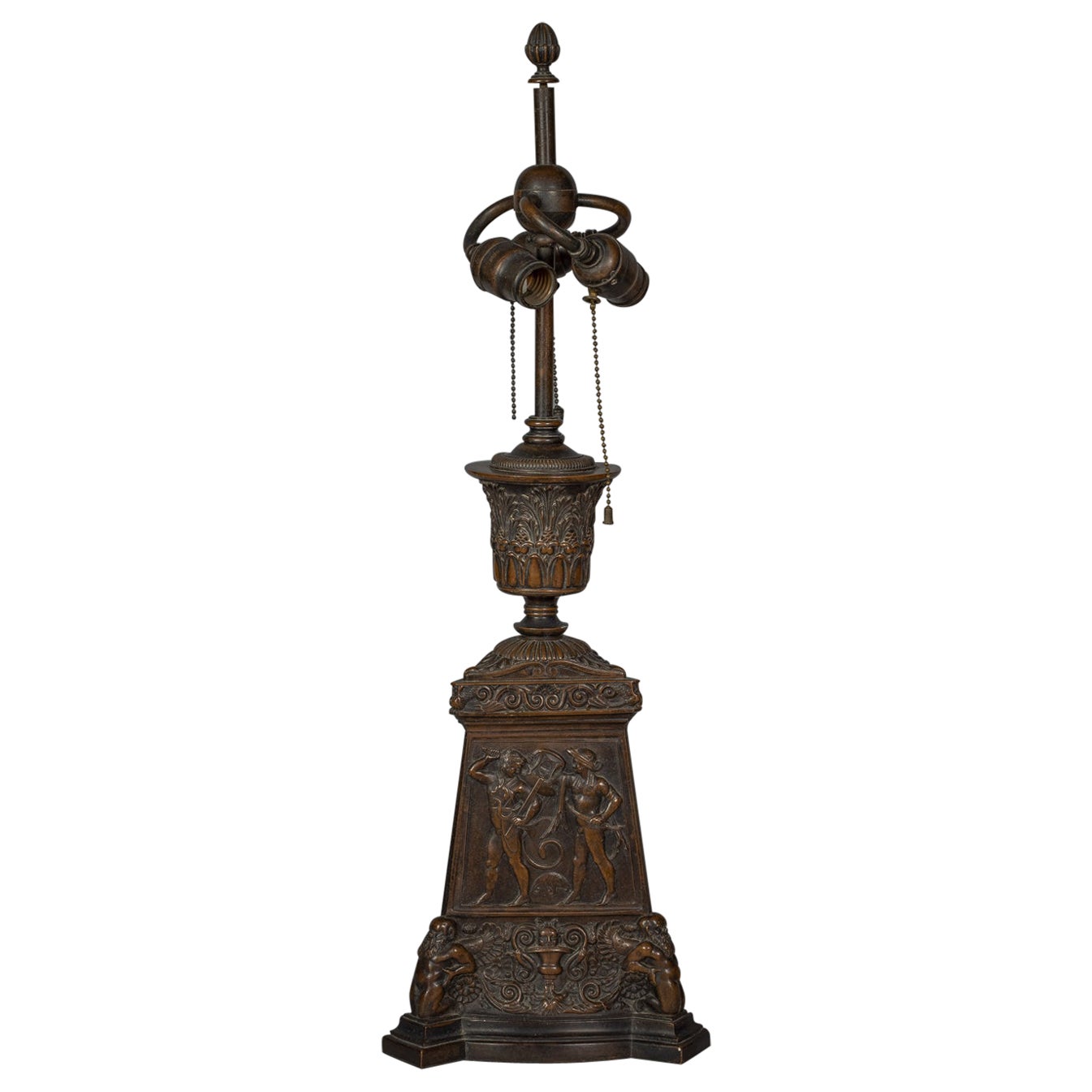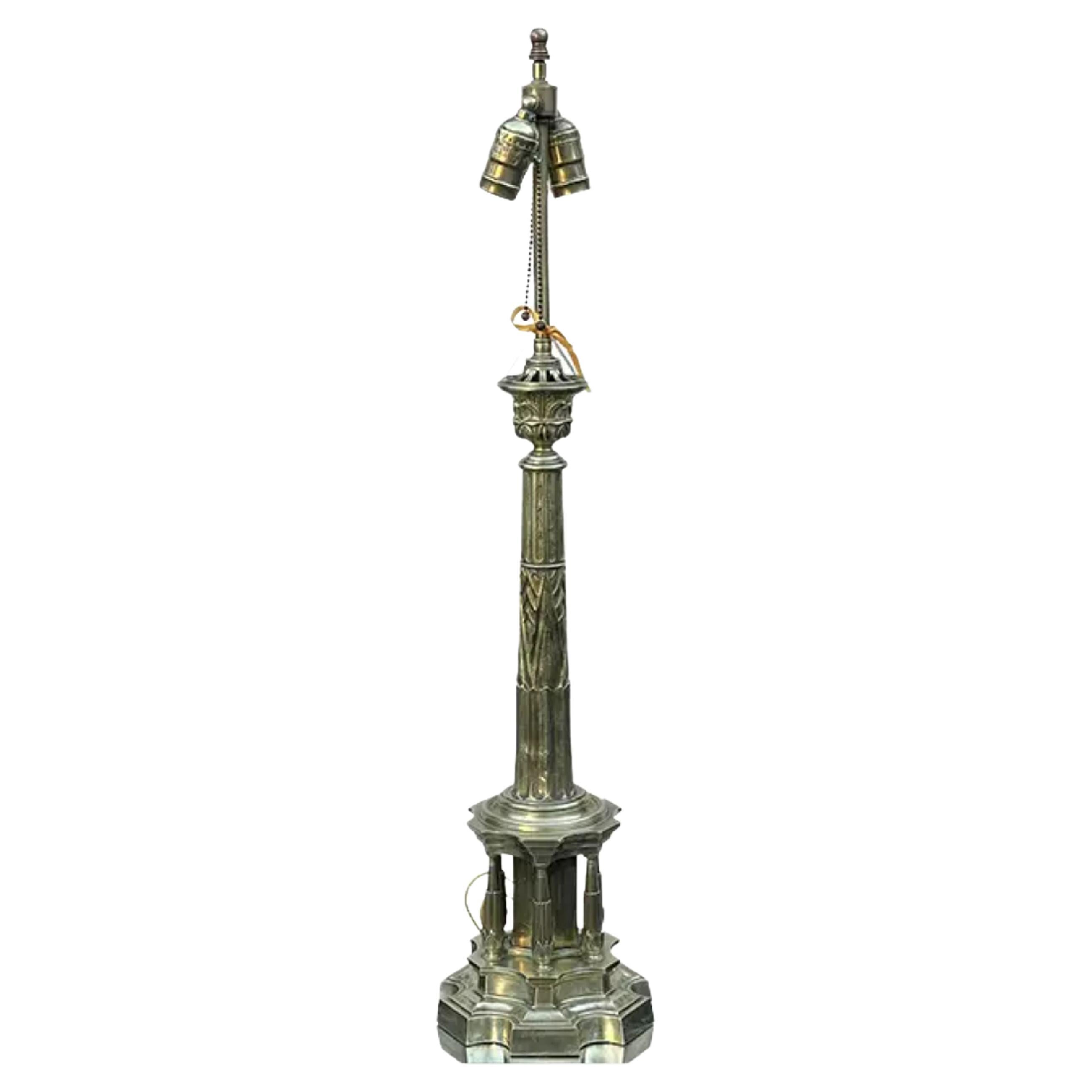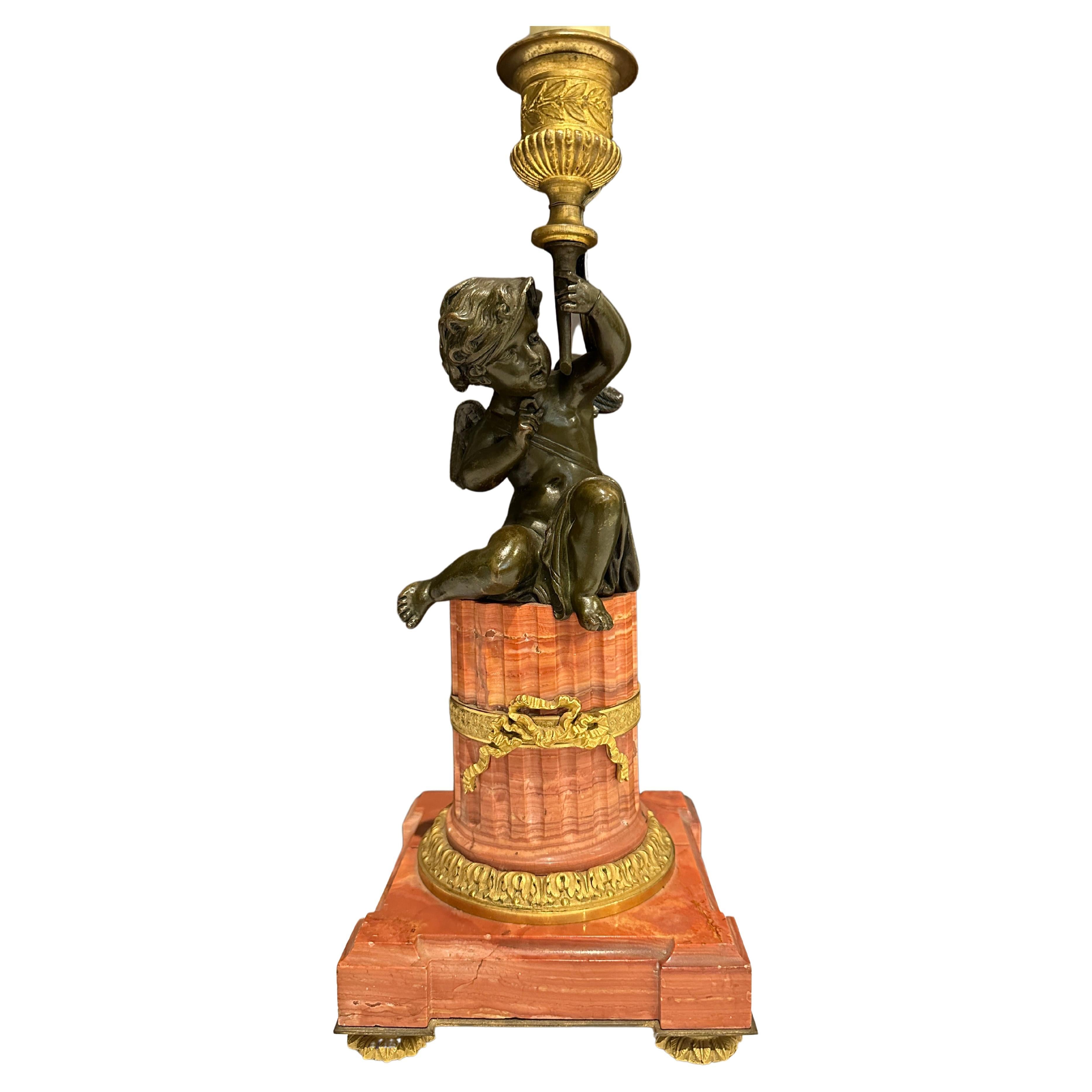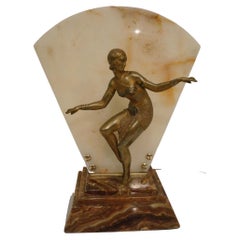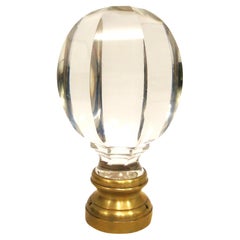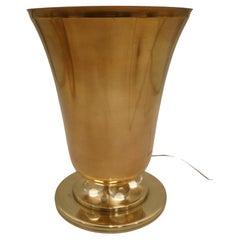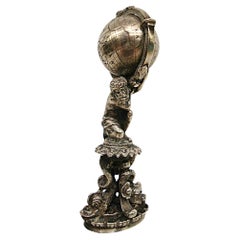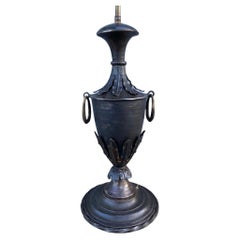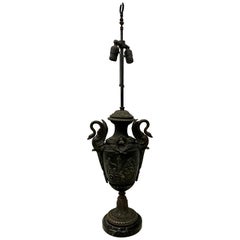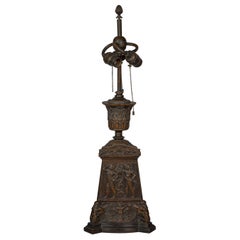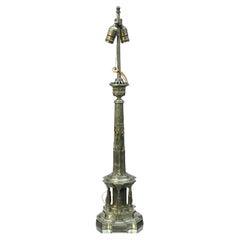Items Similar to Thomas Messenger and Sons 'Atlas' Sculpture Bronze Lamp Base, England circa 1835
Want more images or videos?
Request additional images or videos from the seller
1 of 16
Thomas Messenger and Sons 'Atlas' Sculpture Bronze Lamp Base, England circa 1835
$7,140
£5,388.36
€6,168.86
CA$10,069.77
A$11,055.35
CHF 5,767.60
MX$133,785.11
NOK 72,287.90
SEK 68,114.21
DKK 46,048.89
About the Item
Thomas Messenger and Sons 'Atlas' Sculpture Silvered Bronze Lamp Base, England circa 1835.
English William IV period, bronze table lamp by the Birmingham firm of Thomas Messenger and Sons depicting Atlas supporting the earth with swiveling ring. Originally a sinumbra lamp, it was converted to electricity in the early 20th century. The size of the sculpture without the rod with the fixings is 61 cm / 24 inch.
Additional search terms: English Regency, Regency, Georgian, George, Neoclassical, Classical, Empire, Federal, Greek, Roman, Greek Revival, Victorian, Grand Tour, country house, earth, globe, terrestrial, celestial, armillary, sphere, planet, mythology, library
We have specialized in the sale of Art Deco and Art Nouveau and Vintage styles since 1995. If you have any questions we are at your disposal. Pushing the button that reads 'View All From Seller'. And you can see more objects to the style for sale. Why are there so many antiques in Argentina?
In the 1880 – 1940 there was a grate wave of immigration encouraged by the periods of war that were taking place. 1st World War took place between 1914 and 1918 2nd World War took place between 1939 and 1945 The immigrants options were New York or Buenos Aires. Tickets were cheap and in Buenos Aires they were welcomed with open arms, as it was a country where everything was still to be done. Argentina was the country of new opportunities, labour was needed and religious freedom was assured, in many cases the of the family travel first until they were settled and then the rest of the family members join them. In the immigrant museum “Ellis Island Immigrant Building” in New York you can se the promotional posters of the boats that would take them to a new life. Between the years 1895 and 1896, Argentina had the highest DGP (gross domestic product) per capita in the world according to the Maddison Historical Statistics index, this situation arose due to the large amount of food being exported to European countries, which were at war. The Argentinean ships left the port of Buenos Aires with food, but they returned with furniture, clothes and construction elements, (it´s common to see this the old buildings of the historic neighbourhood of San Telmo, the beams with the inscription “Made in England)”, as well as many markets that were built in Buenos Aires, such us the San Telmo Market, whose structure was brought by ship and afterwards assembled in 900 Defensa Street. With the great influence of European immigrants living in the country, the children of the upper classes travelled to study in France, resulting in the inauguration of “La Maison Argentinienne”, on 27th of June 1928, in the international city of Paris, which hosted many Argentinians that were studying in Frace. It´s the fourth house to be built after France, Canada and Belgium, being the first Spanish-speaking one. Still in place today (17 Bd Jourdan, 75014, Paris, France). Many of the children of these wealthy families who attended international art exhibitions, museums and art courses abroad, took a keen interest in the European style. This is why Buenos Aires was at the time referred as “The Paris of South America”. Between the years 1890 and 1920 more than a hundred Palaces were built on Alvear Avenue the most exclusive avenue in Buenos Aires. Today some of these palaces have been transformed into museums, hotels and embassies. In the year 1936, the Kavanagh building was inaugurated, it was the tallest reinforced concrete building in South America. During 1994 the American Society of Civil Engineers distinguished it as an “international engineering milestone”, and it´s now considered a World Heritage of Modern Architecture. At the time was common to hire foreign architects such as Le Corbusier, who visited Buenos Aires/Argentina in 1929 and in 1948 he drew up the blueprints for a house built in La Plata City (which was declared a World Heritage Site). In 1947, the Hungarian architect Marcelo Breuer designed “Parador Ariston” in the seaside city of Mar del Plata. After an Argentinean student at Harvard University convinced him to come to Argentina. He worked on an urban development project in the Casa Amarilla, area of La Boca. The Ukrainian architect, Vladimiro Acosta, arrives in Argentina in 1928 and worked as an architect until que moved to Brazil. Antonio Bonet, a Spanish architect who worked with Le Corbusier in Paris, arrives in Argentina in 1937, where he carried out several architectural works and in 1938 designs the well-known BFK chair. Andres Kálnay, of Hungarian origin, made around 120 architectural masterpieces, among which the former Munich brewery stands out, he even made the furniture’s design. The German architect, Walter Gropius, director of the Bauhaus, lived in Argentina, where he wrote articles for “Sur” magazine and founded in Buenos Aires, an architectural firm with Franz Möller, who was also an architect, where he built two houses. At the same time several famous designers decided to immigrate to Argentina, among them we can find the well-known French designer, Jean-Michel Frank, who arrived in the country in 1940 and also worked for the Rockefeller family. Special pieces were made, which were sold exclusively in the country, such as the well-known German company “WMF”, who sold their products by catalogue, which were chosen by the ladies of high society in the list of wedding gifts, as well as the pieces designed by Christofle. The Swiss sculptor Alberto Giacometti, made special pieces for Argentinean mansions. In 1904 the first Jansen branch outside Paris was established in Buenos Aires, as the Argentinean clientele demanded a large amount of furniture, from the end of the 19th century to the mid-20th century. In 1970, the brand Rigolleau Argentina made pieces authorised by Lalique. The brands Maple and Thompson also set up shop in the country. The French plastic artist, Marcel Duchamp moved to Argentina in 1918-1919. Glass signed Gallé, Charder, Leverre, Schneider, Muller and other French firms. They were bought in flower shops and were given to ladies with beautiful floral arrangements. Some furniture manufacturers travelled to international fairs and bough the patterns to produce the furniture in Argentina, such as the furniture firm Englander and Bonta, who bought the patterns in Italy. It is worth mentioning that in Argentina we have the largest community of Italians outside of Italy, as it is estimated that 70 percent of the inhabitants have at least one Italian descendant, followed by Spanish immigrants. The most Important furniture stores in Argentina: Comte is founded in 1934 (under the direct management of Jean Michel Frank in 1940). Nordiska (Swedish company established in 1934). Churba in 1960, a company that brought foreign designers to present their furniture in the country: Denmark: (Arne Jacobsen, Finn Juhl, Bender Madsen, Ejner Larsen, Poul Kjaerholm, Hans Wegner) Sweden: (Hans Agne Jakobsson, Gustavsberg) United States: (Herman Miller) Finland: (Lisa Johansson, Folke Arstrom, Tapio Wirkkala, Alvar Aalto, Timo Sarpaneva) Swedish Factory: (Orrefors) Italy: (Littala, Vico Magistretti, Emma Gismondi, Gae Aulenti, Angelo Mangiarotti, Elio Martinelli, Gianna Celada, Angelo Mangiarotti, Mario Bellini, Carlo Scarpa) Finland: (Olivia Toikka) Plata Lappas (Lappas Silver): a goldsmith shop founded in 1887 in Argentina by Alcibiades Lappas of Greek origin. In 2019, in Argentina took place “the Art Deco world congress” . Argentina currently has more than 100 Art Deco buildings and another 90 Art Nouveau buildings throughout the city of Buenos Aires. Argentina is a country that has not been involved in many wars, which is why it has been a refuge for works of art and antiques from different periods of time, unlike European countries. That is way many collectors, museums and antique dealers from all over the world visit it, you should not miss the opportunity to visit this great country.
- Creator:Thomas Messenger (Manufacturer)
- Dimensions:Height: 39.38 in (100 cm)Width: 6.5 in (16.5 cm)Depth: 6.5 in (16.5 cm)
- Style:Regency (Of the Period)
- Materials and Techniques:
- Place of Origin:
- Period:
- Date of Manufacture:1835
- Condition:Rewired: Rewired for North American use. Replacements made: Originally a sinumbra lamp converted to electricity. Wear consistent with age and use. Wear consistent with age and use.
- Seller Location:Buenos Aires, AR
- Reference Number:1stDibs: LU2027331509432
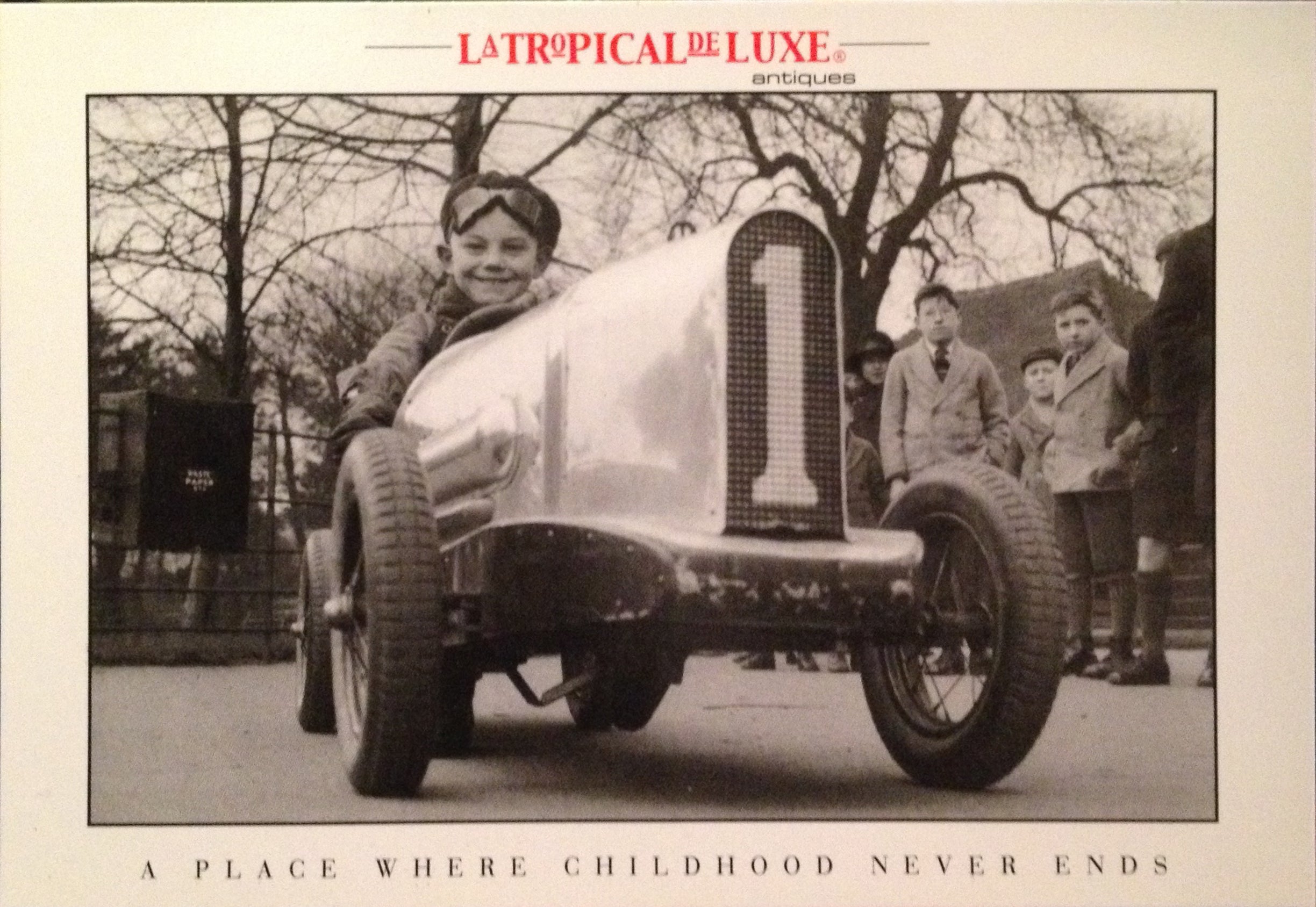
About the Seller
4.9
Vetted Professional Seller
Every seller passes strict standards for authenticity and reliability
Established in 2002
1stDibs seller since 2016
323 sales on 1stDibs
Typical response time: <1 hour
- ShippingRetrieving quote...Shipping from: Buenos Aires, Argentina
- Return Policy
Authenticity Guarantee
In the unlikely event there’s an issue with an item’s authenticity, contact us within 1 year for a full refund. DetailsMoney-Back Guarantee
If your item is not as described, is damaged in transit, or does not arrive, contact us within 7 days for a full refund. Details24-Hour Cancellation
You have a 24-hour grace period in which to reconsider your purchase, with no questions asked.Vetted Professional Sellers
Our world-class sellers must adhere to strict standards for service and quality, maintaining the integrity of our listings.Price-Match Guarantee
If you find that a seller listed the same item for a lower price elsewhere, we’ll match it.Trusted Global Delivery
Our best-in-class carrier network provides specialized shipping options worldwide, including custom delivery.More From This Seller
View AllDemetre Chiparus - Art Deco Bronze Sculpture Lamp France c. 1925 "Delhi Dancer"
By Demetre Chiparus
Located in Buenos Aires, Olivos
Demétre Chiparus - An Art Deco bronze sculpture Table Lamp, France circa 1925 "Delhi Dancer", the bronze dancer mounted on a substantial brown marble base with an illuminated honey o...
Category
Early 20th Century French Art Deco Figurative Sculptures
Materials
Marble, Bronze
Rare Large Bronze and Crystal Newel Post Finial. France 19 Century
By Baccarat
Located in Buenos Aires, Olivos
Large French Crystal, Boule d'Escalier Newel Post Finial, Late 19th c. With paneled sides mounted on original brass or bronze base. In Original conditions. Bacarrat Style. No chips n...
Category
Antique Late 19th Century French Belle Époque Balustrades and Fixtures
Materials
Crystal, Bronze
Art Deco Uplight Brass Metal Table Lamp, French, 1930s
Located in Buenos Aires, Olivos
A lovely example of Art Deco that shows great style and imagination is this French table lamp trumpet shape. Cream coloured on the inside and takes a normal bulb, you can use energy ...
Category
Mid-20th Century French Art Deco Table Lamps
Materials
Brass
Antique God Atlas Sterling Silver Figural Wax Seal Stamper. German 19-Century.
Located in Buenos Aires, Olivos
Antique God Atlas Sterling Silver Figural Wax Seal Stamper.
Rara Antique, circa 1850, wax seal stamp.
Moldelled as the God Atlas (Greek Mythology).
The globe rotates.
Museum quality...
Category
Antique 19th Century German Classical Greek Paperweights
Materials
Silver, Sterling Silver
Napoleon Bronze Sculpture Desk Inkwell, Signed Emile Pinedo
By Émile Pinedo
Located in Buenos Aires, Olivos
Napoleon Bonaparte bronze desk inkwell, signed Pinedo with foundry mark. Mounted over a Green Alps marble.
Antique signed 19th large bronze ...
Category
Antique 1890s French Empire Inkwells
Materials
Bronze
Art Deco Copper and Glass Table Lamp 1940´s
Located in Buenos Aires, Olivos
Art Deco copper and glass table lamp 1940´s. In very good restored conditions. Space style.
We have specialized in the sale of Art Deco and Art Nouveau and Vintage styles since 1995...
Category
Mid-20th Century American Streamlined Moderne Table Lamps
Materials
Brass, Copper
You May Also Like
French Neoclassical Urn Form Steel Table Lamp, 19th Century
Located in Stamford, CT
Neoclassical style urn-form steel lamp with brass oval rings on the sides and repousse acanthus leaf decoration. The round base with a twisted rope for...
Category
Antique Late 19th Century French Belle Époque Table Lamps
Materials
Brass, Steel, Wrought Iron
Vintage Classical Urn Cast Metal Table Lamp, circa 1940s
Located in San Francisco, CA
Vintage Classical urn cast metal table lamp, circa 1940s
8" diameter at the base x 13" diameter at the body
30" high at the socket x 39" high a...
Category
Mid-20th Century American Table Lamps
Materials
Spelter
Neo-Classical Style Patinated Bronze Lamp, E.F. Caldwell, Early 20th Century
Located in New York, NY
Inscribed E.F. Caldwell & co. Inc New York.
Category
Early 20th Century American Table Lamps
Materials
Bronze
Antique Empire Bronze Column Table Lamp, Early 19th Century
Located in LOS ANGELES, CA
Antique 19th century Empire brass column table lamp
Additional information:
Materials: Brass
Color: Gold
Period: early 19th century
Styles: Empire
Lamp Shade: Not Included
...
Category
Antique Early 19th Century Empire Table Lamps
Materials
Brass
Silvered Bronze Lamp Attributed to E.F. Caldwell
By Edward F. Caldwell & Co.
Located in Kilmarnock, VA
A striking silver-plated bronze table lamp, attributed to E.F. Caldwell & Co., one of the most important American lighting firms of the early 20th century. Dating to around 1910, thi...
Category
Vintage 1910s American Table Lamps
Materials
Bronze, Silver Plate
19th Century Louis XVI Bronze and Marble Figural Lamp
Located in Norwood, NJ
Finely chased and modeled 19th Century garniture mounted as a lamp. Beautifully patinated winged cupid holding a cup overhead as if a torch raised on a gilt bronze mounted fluted mar...
Category
Antique Mid-19th Century French Louis XVI Table Lamps
Materials
Marble, Bronze
More Ways To Browse
Antique Lamp Base
Early American New England Furniture
France And Son Finn Juhl
Antique Atlas Furniture
Bronze Sculptured Lamps
Gold Lamp Sculpture
19th Century American Empire Table
1920s Art Deco Wedding Ring
Celestial Globe
Antique Celestial Globe
Silver Lamp Base
Atlas Sculpture
Earth Globe
Antique Armillary Sphere
Celestial Sphere
19th Century Office Swivel Chairs
Antique Swivel Office Chair 20th Century
Armillary Globe
